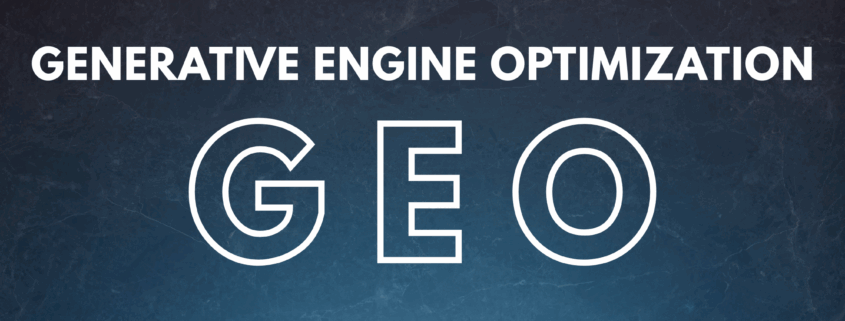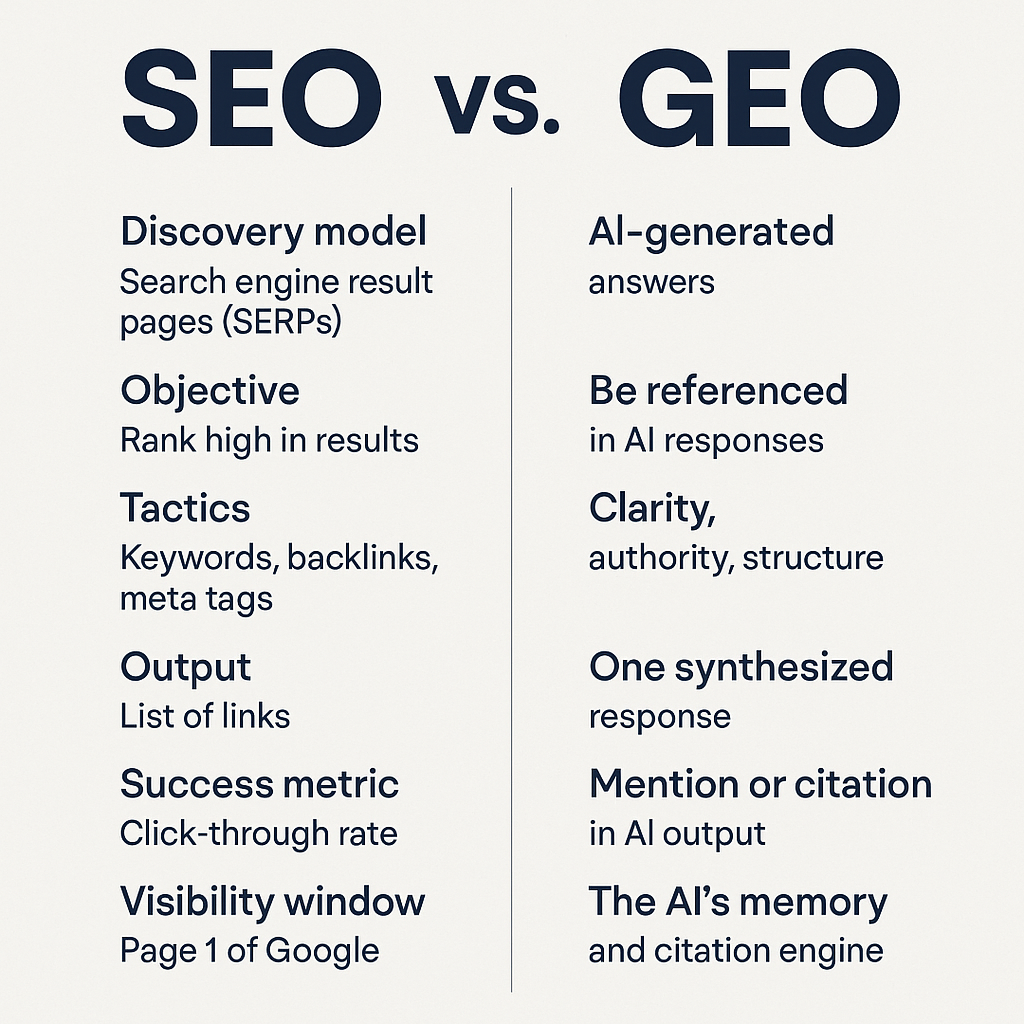SEO is Out. GEO is In: Why Generative Engine Optimization Is the Future
Search used to be simple: just Google it. But in 2025, that’s no longer the default.
Thanks to generative AI, users are skipping the search engine altogether. Instead of clicking through links, they’re getting direct answers from chatbots like ChatGPT, Claude, and Perplexity. This new behavior is upending everything we know about Search Engine Optimization (SEO).
In this blog, we’ll explore the rise of Generative Engine Optimization (GEO), how it’s different from both SEO and SEvO, and what marketers need to do right now to stay visible in a world where AI decides what gets seen – and what doesn’t.
From Search to Synthesis: The AI Shift
In 2024, around 15 million adults in the United States claimed to have used generative artificial intelligence (AI) as their primary tool for online search. By 2028, this number is projected to reach over 36 million online users. Gartner even predicts traditional search traffic will drop by 25% by 2026.
This is more than a trend – it’s a paradigm shift. Users are no longer browsing; they’re asking and receiving. AI acts like a tour guide to the web’s knowledge, giving users curated, synthesized answers with little or no need to click through to external sites.
Great for users. Disruptive for marketers.
SEO vs. GEO: Same Goals, Different Game
| Factor | SEO (Search Engine Optimization) | GEO (Generative Engine Optimization) |
| Discovery Model | Search engine result pages (SERPs) | AI-generated answers |
| Objective | Rank high in results | Be referenced in AI responses |
| Tactics | Keywords, backlinks, meta tags | Clarity, authority, structure |
| Output | List of links | One synthesized response |
| Success Metric | Click-through rate | Mention or citation in AI output |
| Content Format | Optimized for Google indexing | Optimized for LLM understanding |
| Visibility Window | Page 1 of Google | The AI’s memory and citation engine |
With SEO, you fought to be the top blue link. With GEO, your goal is to be the quote inside the answer.
Tap the image below for a free, downloadable PDF you can reference on SEO vs. GEO.
Why GEO Matters Now
Generative search engines don’t list your site – they summarize your content, maybe name-drop your brand, and move on. If your content isn’t clear, up-to-date, or easily quotable, you risk being invisible.
AI prioritizes:
- Authority and clarity over keyword density
- Freshness and fact-checking to avoid outdated info
- Structure that makes it easy to extract answers
- Context and consistency across your web presence
Marketers who fail to optimize for these signals risk losing traffic, even if their SEO is flawless.
GEO in Action: Real Impacts on Traffic and Visibility
Early adopters of GEO tactics are seeing their brands cited in ChatGPT and Perplexity answers. Meanwhile, content publishers reliant on SEO alone report traffic drops when AI snippets replace the need to click.
Some companies are even creating “Key Takeaways for Bots” sections, inserting FAQs at the end of blogs, and writing in a Q&A style to increase chances of being quoted by AI.
Visibility is no longer about pageviews alone. In the GEO era, brand mentions by AI may be just as powerful.
Beyond Google: Where SEvO Fits Into the SEO–GEO Evolution
While GEO is redefining how we show up in AI-powered tools like ChatGPT and Perplexity, another critical strategy is still gaining traction alongside it: Search Everywhere Optimization (SEvO).
If GEO is about becoming the answer in AI-driven conversations, SEvO is about being discoverable anywhere consumers search – not just Google.
In 2025, “search” isn’t a single action. It’s a behavior that happens on multiple platforms depending on the context:
- Consumers turn to YouTube for how-to videos.
- They search TikTok for trending products.
- They browse Amazon for comparisons and reviews.
- They discover on Instagram, Pinterest, even Reddit.
A recent survey by Forbes Advisor shows that nearly a quarter of people now rely entirely on social media to search online, with Gen Z leading the shift. In other words, if your SEO strategy still starts and ends with Google, you’re missing where the search journey really begins.
So where does SEvO fit?
- SEO was about optimizing for Google.
- SEvO expands your reach to search everywhere your customers are.
- GEO ensures you show up in AI-generated answers – before they ever reach a search bar.
At Onimod Global, we view SEvO and GEO as complementary strategies. Together, they create a multi-layered approach to visibility in today’s fragmented, AI-driven digital landscape.
Want to be everywhere your audience is looking and answering their questions before they even ask? Blend SEvO + GEO. That’s the future.
What Marketers Should Do Right Now
To win in a GEO world, marketers must:
✅ Write for both humans and machines – Structure content with clear headlines, summaries, and FAQ sections
✅ Lead with the takeaway – Don’t bury your insight; AI might only grab two lines
✅ Be original and authoritative – Opinionated, data-backed, or highly useful content stands out
✅ Stay fresh – AI avoids outdated sources, so keep publishing regularly
✅ Track your mentions – Start monitoring where your content shows up in AI outputs
GEO isn’t a replacement for SEO, but the evolution of it. Both matter. But the brands optimizing for AI-first discovery will dominate tomorrow’s marketing landscape.
Conclusion: The Future Isn’t Search. It’s Synthesis
AI is changing how people find and consume information. As generative engines become the default interface to the internet, the race to “rank on Google” is becoming a race to “be the answer.”
SEO is still relevant, but it’s no longer enough. GEO is the new frontier, where the winners are the brands that understand what AI values: clarity, credibility, and context.
If you want to future-proof your digital marketing, the time to act is now.
Let’s Talk Strategy
At Onimod Global, we help brands adapt to every shift in the digital landscape: from Google algorithm changes to AI-powered disruption. Whether you’re rethinking SEO, launching GEO-focused content, or exploring how AI can boost your ROI, we’re here to help.
📞 Contact us today at onimodglobal.com and let’s future-proof your strategy.
FAQs
Q1: What is GEO?
GEO (Generative Engine Optimization) is the practice of optimizing your content to be referenced or cited by AI tools like ChatGPT and Perplexity instead of just ranking in search results.
Q2: Does this mean SEO is dead?
Not entirely, but its dominance is fading. GEO complements SEO, but focuses on how AI consumes and delivers your content.
Q3: How can I optimize for GEO?
Structure your content clearly, lead with concise takeaways, update regularly, and aim to be quotable. Focus on writing for both humans and machines.
Q4: Is GEO measurable?
It’s still early, but some tools are emerging to track AI mentions. You can also monitor increases in branded search or direct traffic from AI interfaces.
Q5: Should small businesses care about GEO?
Absolutely. GEO is a powerful equalizer. Smaller, nimble brands that create high-quality, AI-friendly content can outpace larger competitors who don’t adapt.












